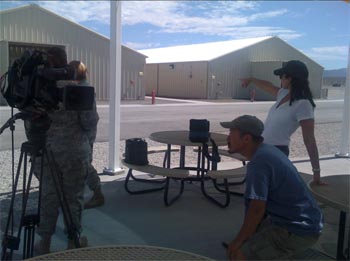 Today, American air combat very often looks like this: two people, a pilot with traditional Air Force flight training and a typically younger sensor operator with no necessary flight experience at all, sitting next to each other at a large console surrounded by computer screens. Both the pilot and the sensor are responsible for up to 8 screens each. They're also controlling joysticks and throttles to direct the plane and its high-tech camera, they're making notes on a whiteboard, they're typing away at keyboards to send messages in a secure AOL-like chat room, and they're talking via radio to guys on the ground in the war zone.
Today, American air combat very often looks like this: two people, a pilot with traditional Air Force flight training and a typically younger sensor operator with no necessary flight experience at all, sitting next to each other at a large console surrounded by computer screens. Both the pilot and the sensor are responsible for up to 8 screens each. They're also controlling joysticks and throttles to direct the plane and its high-tech camera, they're making notes on a whiteboard, they're typing away at keyboards to send messages in a secure AOL-like chat room, and they're talking via radio to guys on the ground in the war zone.
We witnessed this symphony of multitasking recently while we filmed at Creech Air Force base in the Nevada desert, about an hour from the Las Vegas strip. Here, the Air Force flies constant, round-the-clock missions, gathering surveillance, supporting ground troops and sometimes unleashing weapons. The pilots are not physically inside the planes -- they sit at Creech, working from small, heavily air-conditioned rooms and trailers. The planes themselves are at least 7000 miles away, somewhere over Iraq or, these days more likely than not, Afghanistan. Each plane can carry a number of Hellfire missiles, and the larger models can release 500-pound bombs.
 A lot of people have been tempted to analogize remote flying to a video game. While the agile brain work required to dominate Call of Duty may be similar, each pilot and sensor operator I met at Creech firmly insisted on one major difference: when they fly, and when they fire weapons, there is no reset button. Despite the great physical distance and the experience of war mediated through screens, the pilots and sensors must convince themselves that they're right there in the fight, in the mountains and towns of Afghanistan or Iraq. They say the mental acrobatics help them from becoming detached.
A lot of people have been tempted to analogize remote flying to a video game. While the agile brain work required to dominate Call of Duty may be similar, each pilot and sensor operator I met at Creech firmly insisted on one major difference: when they fly, and when they fire weapons, there is no reset button. Despite the great physical distance and the experience of war mediated through screens, the pilots and sensors must convince themselves that they're right there in the fight, in the mountains and towns of Afghanistan or Iraq. They say the mental acrobatics help them from becoming detached.
One pilot described the feeling of being pulled in to a battle that's occurring thousands of miles away via video screen:
"It's very easy to go from, oh, I'm looking at an intersection, I'm looking at an intersection. And then all of a sudden, you hear troops in contact. You hear the guy calling on the radio and you hear, I mean, gunfire and explosions and everything ripping by his nugget there. And you're just like, yeah, I need to get there right now and help this guy. It's very easy to go from zero to completely spun up in this aircraft."
-- Caitlin
Comments
"While the agile brain work required to dominate Call of Duty may be similar, each pilot and sensor operator I met at Creech firmly insisted on one major difference: when they fly, and when they fire weapons, there is no reset button."
I find this comment hilarious. When have we seen a drone pilot die because the aircraft he remote controlled was shot down by anti-aircraft fire or crashed due to an engine malfunction? Is the military installing ejection seats on each computer workstation? Do they have rescue operations to retrieve these drone pilots after they fall off their comfy chairs while flying?
Rommel / October 18, 2009 _ 05:34After 13 years of military duty I understand the Creech pilot's description of the 'remote' experience to a degree. When you man a radio watch, you are connected to the operation, but removed by distance too. But, when you start receiving urgent communications and have to coordinate/relay that information, you are immediately connected to the event - emotionally, intellectually, and operationally. The fact that your actions and choices have real world impact is what makes it 'real' regardless of the distance.
Paul Martin / December 22, 2009 _ 00:18